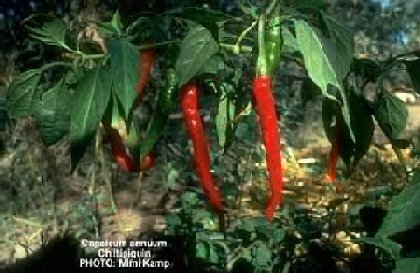
Cayenne
Chad Bradshaw

Introduction:
Cayenne is derived from the Capsicum annuum plant of the Solanaceae family. It is known more commonly as red chile pepper. The plant is native to North and South America and has been cultivated almost worldwide. The plant grows to about 30" in height and can be harvested when green and left to ripen, or can be left on the plant to ripen. It is not the dried rind or seeds that have the hot taste associated with this herb, but is the veins of the fruit.
Chemistry and Pharmacology:
The active principle in cayenne and other chile peppers is an oleoresin that contains predominately the compound capsaicin. Other active elements of the oleoresin, in lesser quantities, have the double bond saturated and/or a variable number of methylene groups between the amide and the gem-dimethyl groups. The "heat" of the pepper is defined in Scoville Units, where 1 ppm capsaicinoid = 15 Scoville Units. The allopathic use of capsaicin is as a topical analgesic and counterirritant. It has been shown to deplete the nerves of Substance P, a neuropeptide involved in pain response both peripherally and centrally. The sequence of events is that initial application of capsaicin produces a burning sensation as Substance P is released. The cream is applied, usually four times per day, for 1-2 weeks, during which time the burning sensations lessen as less Substance P is released. Usual time course for maximum benefit is 4-6 weeks.
Folk Usage:
The herb has been touted as a general stimulant and can be found in many preparations in combination with other herbs for everything from menopause to impotence, from increasing cognitive functions to stress relievers.It has been claimed to lower blood pressure, protect from stroke and heart attacks, lower cholesterol, cool the body in warm climates, reduce weight, and increase vision.
Clinical Applications:
Post-herpetic neuralgia
Topically-applied capsaicin is FDA-approved for the treatment of pain associated with shingles (herpes zoster). Various studies have shown that about 50% of patients will respond to topical capsaicin compared to 10% placebo.
Trigeminal neuralgia (tic douloureux)
A painful disorder of the main nerve of the face characterized by severe, stabbing pain affecting the cheek, lips, gums, or chin, this condition rarely responds to any therapy other than surgery. In a study of 12 patients, topically applied capsaicin was shown to provide complete relief of pain from this syndrome in six patients. Partial relief was seen in four patients. Of the ten responders, four relapsed in 95-149 days, however a second course of therapy did not result in relapse for the remainder of the treatment year.
Postmastectomy pain
In one double-blind study, 23 patients with postmastectomy pain applied either capsaicin (0.075%) or vehicle-only cream four times daily for 4-6 weeks. Thirteen patients responded with at least a 50% reduction in jabbing pain, in category pain severity scales, and in overall pain relief scales. Only four patients responded to vehicle only preparations.
Diabetic neuropathy
One large double-blind 8-week study enrolled 277 men and women with painful diabetic neuropathy of the hands and feet. 69.5% of the group applied capsaicin cream (0.075%) and showed improvement compared to 53.4% who applied a vehicle-only preparation.
Psoriasis
One double-blind study enrolled 44 patients with symmetrically distributed psoriasis lesions. Patients applied capsaicin to one side of their body and a placebo to the other side. After 3-6 weeks, significantly greater reductions in scaling and redness were observed on the capsaicin-treated side.
Dosage
Creams containing 0.025% or 0.075% capsaicin may be applied to affected areas up to four times daily.
Toxicity
Cayenne pepper is generally recognized as safe. When applied topically, a burning sensation is to be expected. The effect will diminish with time (as Substance P is depleted) and rarely necessitates discontinuation of the cream.
Clinical Trials of Topical Capsaicin Creams
The active component of cayenne, capsaicin, is available in 0.025-0.25% creams for topical application as an analgesic. It has been reported to provide relief for people with post-herpetic neuralgia, psoriasis, pruritis, arthritis, headaches, and diabetic neuropathy. While some of these clinical trials are of dubious value, due either to small sample size, open label groups, high placebo effects, or other medications taken concurrently, there is some evidence to support the use of capsaicin topically, especially since it is generally regarded as safe for use.
Surles J. Cayenne. Presentation handout, Pharmacy 100, Fall semester 1997, University of North Carolina School of Pharmacy, Chapel Hill, NC.
Murray, MT. The Healing Power of Herbs. 2nd edition. Prima Publishing, Rocklin CA; pp.70-76.
Mowrey, DB. The Scientific Validation of Herbal Medicine. Keats Publishing, New Cannan, CT.
The Handbook of Nonprescription Drugs. 11th edition; Amer. Pharm. Assoc. Washington, DC; 1996; pp. 83-85.
Effect of Capsaicin on Lipid Metabolism in Rats Fed a High Fat Diet. J Nutr 1986; 116(4):1272-1278.
Effects of topically applied capsaicin on moderate and severe psoriasis vulgaris. J Amer Acad Dermatol 1986; 15(3), 504-507.
Topical Capsaicin in Painful Diabetic Neuropathy. Diabetes Care 1992; 15(1):8-14.
Effect of Treatment with Capsaicin on Daily Activities of Patients with Painful Diabetic Neuropathy. Diabetes Care 1992; 15(2):159-165.
Treatment of Arthritis with Topical Capsaicin: A Double Blind Trial. Clin Therapeut 1991; 13(3):383-395.
Uremic Pruritis. Amer J Health-Sys Pharm 1996; 53(18):2159-2170.
Euphorbium: Modern Research on Its Active Principle, Resiniferatoxin, Revives an Ancient Medicine. Life Sci 1997; 60(10):681-696.
Post-herpetic neuralgia: 208 cases. Pain 1988; 35(3):289-297.
Phase III Placebo-Controlled Trial of Capsaicin Cream in the Management of Surgical Neuropathic Pain in Cancer Patients. J Clin Oncol 1997; 15(8):2974-2980.